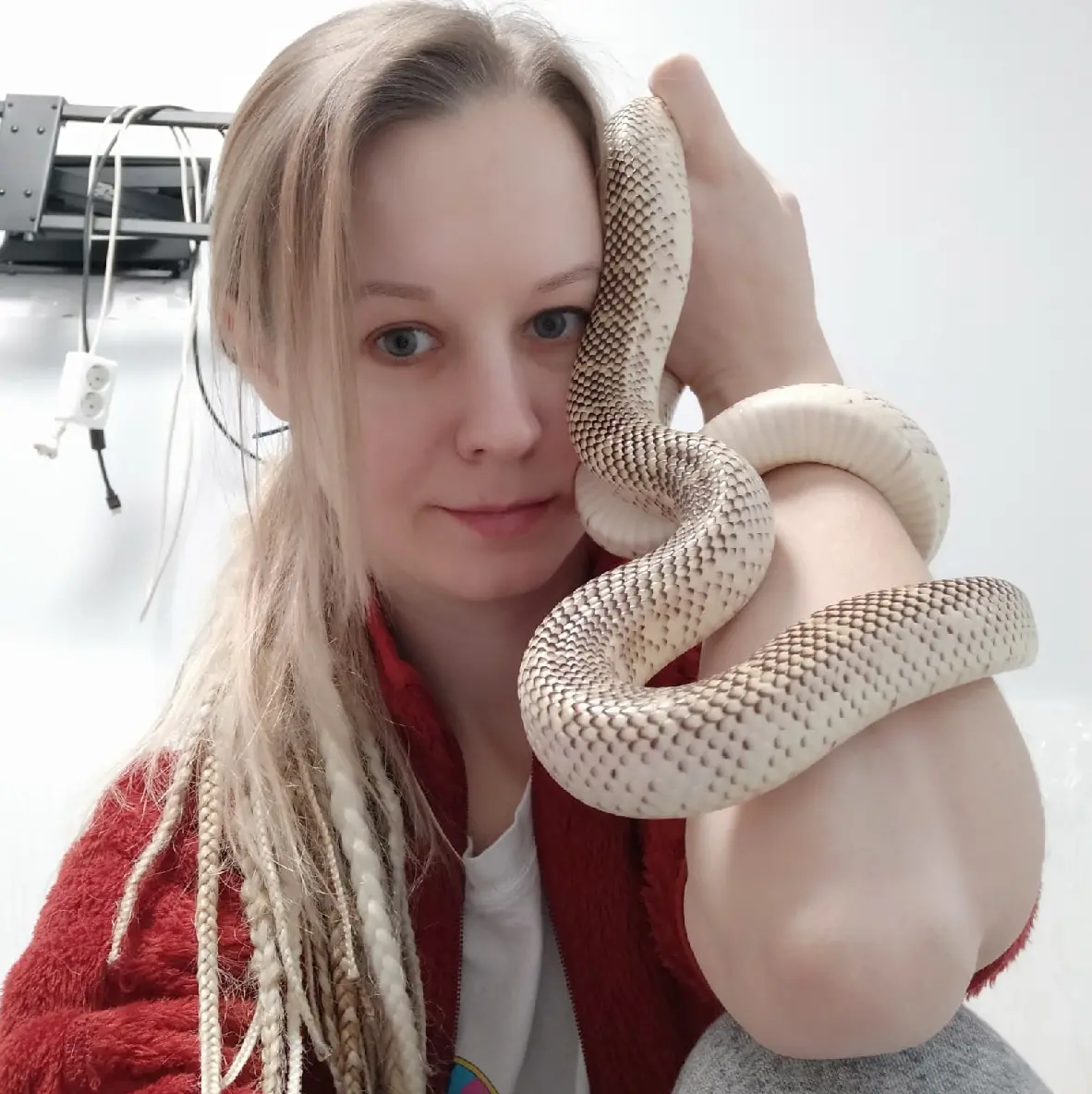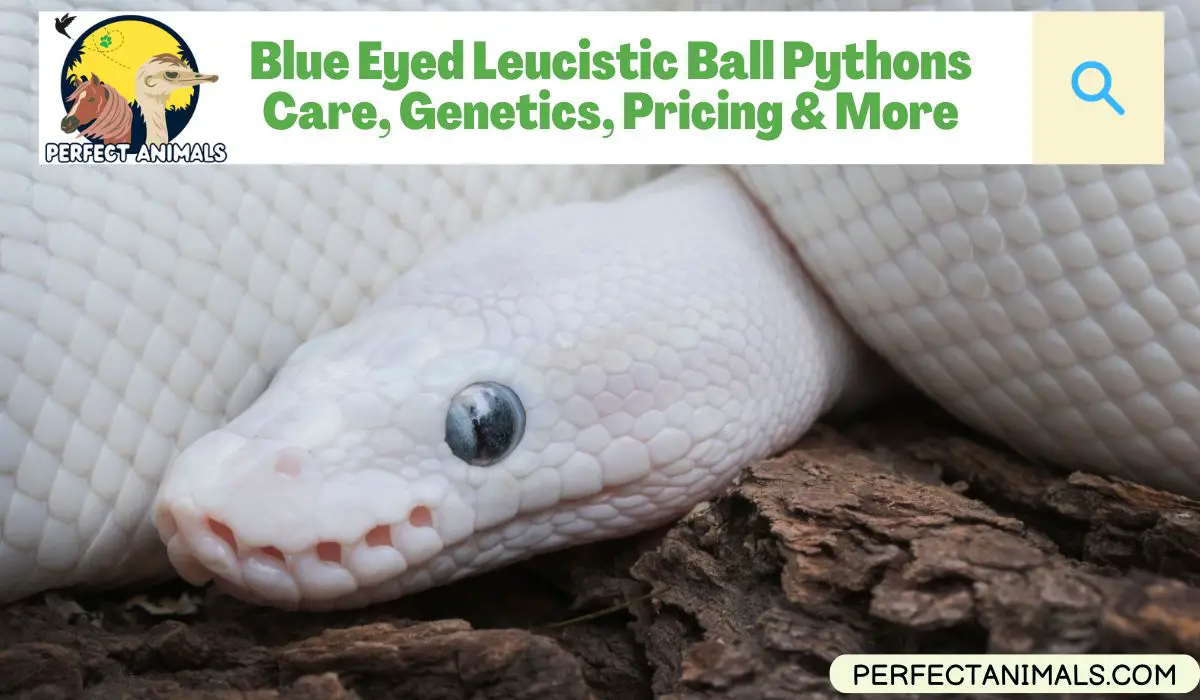Leucistic ball pythons stand out for their brilliant white scales and mesmerizing blue eyes.
But besides their stunning looks, these beautiful snakes have some fascinating genetics and care requirements.
In this article, we’ll explore everything you need to know about the rare and eye-catching blue eyed leucistic ball python.
We’ll discuss what makes them different, how they get their unique traits, their temperament, ideal habitat, feeding needs, and more.
Whether you’re just curious to learn about these remarkable reptiles or you’re considering getting one as a pet, you’ll find all the key information right here.
So keep reading to learn all about the mystique of the blue eyed leucistic ball python!
How Rare Are Blue Eyed Leucistic Ball Pythons?
Blue eyed leucistic ball pythons are incredibly rare, even among morphs and mutations of ball pythons.
Their unique appearance is the result of a very uncommon genetic combination that removes all black or brown pigment from the snake’s scales.
This results in a brilliant white snake with mesmerizing blue eyes.
In the wild, the genetic combination behind the blue eyed leucistic morph almost never occurs naturally.
That makes encountering one extremely unlikely. Among breeders and ball python enthusiasts, these snakes are also notoriously difficult to produce.
The genetics must be just right to result in hatchlings with the blue eyed leucistic traits.
Even when carefully planned out, breeding attempts often fail to produce the desired morphs.
Overall, the challenges of reproducing these snakes combined with their natural rarity contributes to their exceptional uniqueness in the ball python world.
Most reptile enthusiasts may never encounter one in person.
Their vibrant scales and sapphire eyes are a truly extraordinary sight due to the incredibly scarce numbers of blue eyed leucistic ball pythons in existence.
Related Article – Albino Ball Python
Are Blue Eyed Leucistic Ball PythonS Venomous?
Like all ball pythons, the blue eyed leucistic variety is nonvenomous and completely harmless to humans.
Ball pythons are constrictor snakes, meaning they subdue their prey through tight squeezing rather than injecting venom.
The blue eyed leucistic morph has the same temperament and behavior as a normal ball python, without any increased danger.
As ball pythons, blue eyed lucies are quite docile, even for snakes.
Their calm nature makes them a popular first pet snake. With gentle handling, they rarely bite or strike. It’s important to move slowly and confidently when picking up a blue eyed leucistic ball python to avoid startling them.
But overall, they do not pose any threat of venom, toxin, or danger to their owners.
Their vivid white scales and blue eyes may give them an exotic look, but blue eyed leucistic ball pythons are just as friendly and safe to handle as any other ball python type.
What Do Blue Eyed Leucistic Ball Pythons Eat?
Like all ball pythons, the blue eyed leucistic variety are carnivorous snakes that feast on small prey animals.
In the wild, they would eat small rodents, birds, lizards, and other reptiles.
When kept as pets, their diet consists of feeding on mice, rats, and other rodents.
As hatchlings, blue eyed leucistic ball pythons can be started on a diet of small mice or fuzzy mice. It’s important to select feeder rodents that are not wider than the widest part of the snake’s body.
As they grow, they can graduate to adult mice and eventually small rats.
Feeder rats are the ideal adult food source.
No matter their age, blue eyed leucistic ball pythons should be fed rodents that are appropriate for their size.
Their meals can be given dead or live, though live feedings do risk potential injury to the snake.
As with any pet snake, variety between different rodents can ensure a healthy balanced diet.
With the right feeding routine, blue eyed leucistic ball pythons can thrive on a carnivorous diet of rodents.
Related Article – Are Pied Ball Pythons Right for You?
What is the Price Range for a Blue eyed Leucistic Ball Python?
Due to their rarity, blue eyed leucistic ball pythons demand a high price in the exotic pet trade.
Prices typically range from $400 on the low end to $1,000 for rare color variations or proven breeders.
The average cost is around $700.
Blue eyed lucy hatchlings tend to start around $400 as babies.
Their price goes up as they grow and can be confirmed female or male. Exceptional breeding snakes with sought-after genetics can fetch prices into the thousands.
But the average adult blue eyed leucistic ball python sold as a pet falls in the $700 range.
Pricing is also affected by factors like the breeder’s reputation and morph traits like brightness of scales.
Because they are challenging to produce, breeders must recoup their investment.
Limited availability also allows sellers to demand higher prices for these rare beauties.
With their uniqueness and stunning eyes, blue eyed leucistic ball pythons command premium pricing in the exotic pet trade.
You May Also Like – Bearded Dragon Tail Rot
How to Make Blue Eyed Leucistic Ball Python?
Blue eyed leucistic ball pythons are not a separate species, but rather the result of carefully combining several different ball python morphs through selective breeding.
To produce a blue eyed lucy, breeders must follow these genetic steps:
First, breed a Mojave ball python with a Lesser ball python. This will produce a super mojave ball python offspring.
Next, breed the super Mojave with another Super Mojave. After many attempts and generations, this pairing can eventually result in hatchlings expressing the blue eyed leucistic traits.
However, breeding blue eyed lucies is extremely difficult and requires advanced knowledge of snake genetics.
The mutations must be lined up perfectly. As a beginner breeder, I do not recommend trying to produce these morphs without guidance.
Working with experienced mentors is the best way to learn the intricacies of genetically engineering rare ball python traits.
Attempting to breed blue eyed lucies through trial and error would be frustrating and unlikely to produce results.
Partnering with an expert breeder is the best path to successfully making blue eyed leucistic ball pythons a reality.
With the right genetic foundations in place, the striking eyes and scales of these snakes can be achieved.
How to Care for a Blue Eyed Leucistic Ball Python?
Caring for a blue eyed leucistic ball python requires paying close attention to their environment and dietary needs.
Based on my experience, here are some tips.
Enclosure
Blue eyed lucies need a suitably sized tank, with hatchlings requiring a 36L x 18W x 12H inch enclosure.
Adults need at least a 48L x 24W x 12H inch habitat. Proper sealing to prevent escape is crucial.
Temperature
Maintain a temperature gradient using a heat lamp or pad.
The warm side should be 85-91°F and the cool side 75-80°F. Use thermometers to regularly monitor.
Humidity
Humidity in the tank should stay around 60%.
Use moisture-retaining substrates like coconut fiber and monitor with hygrometers. Provide a humid hide box.
Lighting
Offer 12 hours of light and 12 hours of darkness daily using a low wattage bulb.
Diet
As explained before, Hatchlings can eat pinky or fuzzy mice every 5-7 days.
Juveniles eat mice every 7-10 days.
Adults should get appropriately sized rats. Provide fresh, clean water always.
Handling
Handle gently and deliberately. Wash hands before and after.
Limit handling after feeding for proper digestion.
With the proper enclosure setup, temperature regulation, humidity maintenance, lighting conditions, nutrition, and gentle handling, blue eyed leucistic ball pythons can thrive under human care.
Final Thoughts
The blue eyed leucistic ball python is truly a standout among its fellow pythons.
Their dazzling scales and sapphire eyes are a sight to behold. Yet they require specialized care to bring out their full beauty as pets.
By understanding the rarity of their genetics, their docile nature, dietary needs, ideal habitat conditions, and handling techniques, we can appreciate these snakes for the remarkable animals they are.
Their brilliance comes at no added risk – blue eyed lucies are just as friendly and safe as other ball python varieties.
If the unique allure of the blue eyed leucistic ball python appeals to you, be sure to find a responsible breeder and educate yourself on proper care.
With attention to their needs and gentle handling, a blue eyed lucy can make for a marvelous pet.
Their vibrance brings an exceptional pop of color and shine to any herpetology collection.
FAQs
How much does a blue eyed leucistic ball python cost?
Blue eyed leucistic ball pythons typically cost between $400-$1000, with most averaging around $700. Their rarity drives these high prices.
Why is my blue eyed Lucy ball python pink?
A pink or faded appearance in a blue eyed lucy ball python is often due to a lack of proper heat and lighting.
Ensure adequate heat and UVB exposure to bring out their bright white scales.
Why is my ball python turning red?
Reddish coloration in a ball python usually indicates a burn from excessive heat exposure. Lower temperatures, provide a heat gradient and ensure proper enclosure lighting to return normal coloring.
Resources – (for further reading)
ResearchGate – Leucism and stripe formation in ball pythons ( Python regius ) are associated with variants affecting endothelin signaling
Animal Diversity Web – ADW: Python regius: INFORMATION

Hannah owns a collection of reptiles, from geckos to snakes, and her home is essentially a living terrarium. Her expertise and passion for reptiles translate into engaging articles that educate and inspire fellow reptile lovers.

